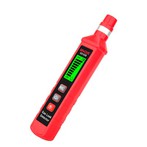Function principle of pitot-tube wind speed sensors
Pitot tube, also known as "air speed tube", "wind speed tube", is the measurement of airflow total pressure and static pressure to determine the speed of airflow of a tubular device, invented by the French H. Pitot and named.
It is difficult to measure the speed of the airflow directly by experimental methods, but the pressure of the airflow can be easily measured with a manometer. It is mainly used to measure the speed of the aircraft, but also has a variety of other functions. Therefore, the pressure can be measured with a Pitot tube and then the speed of the airflow can be calculated by applying Bernoulli's theorem. Pitot tube consists of a round head of the double casing (see figure), the outer casing diameter D, in the centre of the round head O at the opening of a total pressure hole connected to the inner casing, connected to one end of the manometer, the diameter of the hole for the 0.3 ~ 0.6 D. In the outer casing from the side surface of the O about 3 ~ 8 D C at the circumference of the perimeter uniformly open a row of static pressure holes perpendicular to the wall of the outer casing, connected to the manometer on the other hand, the Pitot tube placed in the desire to measure the speed of the constant airflow, so that the tube is used to calculate Bernoulli's theorem of air velocity. Pitot tube is placed in the constant airflow, so that the tube axis and the direction of the airflow is the same, the leading edge of the tube to the incoming flow. When the airflow is close to the O point, the flow rate is gradually reduced, the flow to the O point of stagnation stop for zero. So O point measured is the total pressure P. Secondly, because the tube is very thin, C point from O point is sufficiently far, so C point at the speed and pressure has been basically restored to the same with the incoming velocity V and pressure P equal to the value of the pressure, and therefore measured at C point is the static pressure. For low velocity flow, the equation for determining the flow rate is given by Bernoulli's theorem:
According to the total pressure measured by the manometer and the static pressure difference P-P, as well as the fluid density ρ, can be calculated in accordance with the formula for the speed of the airflow.
Ultrasonic wind speed sensor working principle

The working principle of ultrasonic wind speed sensor is to use ultrasonic time difference method to achieve the measurement of wind speed. Because the sound propagation speed in the air, and the wind direction will be superimposed on the air velocity. If the propagation direction of the ultrasonic wave is the same as the wind direction, then its speed will be accelerated; on the contrary, if the propagation direction of the ultrasonic wave is opposite to the wind direction, then its speed will be slowed down. Therefore, under fixed detection conditions, the speed of ultrasound propagation in the air can correspond to the wind speed function. The precise wind speed and direction can be obtained by calculation. Since the speed of the sound wave propagating in the air is greatly affected by the temperature; the wind speed sensor detects two opposite directions on two channels, so the effect of temperature on the speed of the sound wave is negligible.
The ultrasonic wind sensor is lightweight, has no moving parts, is rugged and requires no maintenance or field calibration, and can output both wind speed and direction. Customers can select the wind speed unit, output frequency and output format according to their needs. Heating (recommended for cold environments) or analogue outputs are also available on request. It can be connected to a computer, data collector or other collection device with RS485 or analogue output compatible. If required, it can also be used in a network of multiple units.
Ultrasonic wind speed and direction meter is a more advanced instrument for measuring wind speed and direction. Because it well overcomes the inherent defects of mechanical anemometer, it can work normally for a long time in all-weather, and is more and more widely used. It will be a strong alternative to mechanical anemometers.





